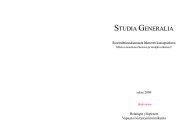the case of the 'urban villas'
the case of the 'urban villas'
the case of the 'urban villas'
Create successful ePaper yourself
Turn your PDF publications into a flip-book with our unique Google optimized e-Paper software.
Dr. Anne Hrychuk Kontokosta<br />
Visiting Assistant Pr<strong>of</strong>essor, Pratt Institute<br />
Research Associate, Institute for <strong>the</strong> Study <strong>of</strong> <strong>the</strong> Ancient World, NYU<br />
Making <strong>the</strong> private public: from elite horti to imperial <strong>the</strong>rmae<br />
In <strong>the</strong> Middle Republic, <strong>the</strong> construction <strong>of</strong> over sixty horti (elaborate garden estates) by <strong>the</strong><br />
city’s elite signaled a new trend in urban domestic living with long‐lasting impacts on <strong>the</strong> art,<br />
architecture, and city‐plan <strong>of</strong> Rome. An alternative to <strong>the</strong> traditional domus, opulent horti,<br />
which may have been inspired by Hellenistic royal palaces, were constructed on <strong>the</strong> outskirts<br />
<strong>of</strong> <strong>the</strong> city ‐ distant and private enough to be unconstrained by traditional social codes, while<br />
close enough for <strong>the</strong>ir owners to stay involved in public life and advertise <strong>the</strong>ir immense<br />
personal wealth. The ambiguous nature <strong>of</strong> horti (suburban/urban; public/private;<br />
Roman/Hellenistic) was reflected by its nomenclature (“vegetable garden”), which <strong>of</strong>fered<br />
positive, traditional connotations for a provocative, new architectural type.<br />
Not until <strong>the</strong> end <strong>of</strong> <strong>the</strong> Republic can literary sources and archaeological evidence<br />
fully attest to <strong>the</strong> function <strong>of</strong> horti as private enclaves for Rome’s most influential public<br />
residents (Caesar, Pompey, Lucullus, Maecenas, Sallust). This paper proposes that while<br />
private horti continued to act as retreats for <strong>the</strong> city’s elite, in <strong>the</strong> imperial period <strong>the</strong>y also<br />
became architectural, decorative, and ‐ in some ways ‐ even functional models for <strong>the</strong> city’s<br />
new public <strong>the</strong>rmae. Imperial <strong>the</strong>rmae <strong>of</strong>fered Romans new types <strong>of</strong> urban experiences<br />
(luxurious gardens, foreign art, libraries, etc.) previously associated with <strong>the</strong><br />
socially‐restricted spaces <strong>of</strong> Roman horti. To <strong>the</strong> ancient viewer, <strong>the</strong> connection would have<br />
been visually explicit when M. Agrippa built <strong>the</strong> first imperial bath (25BCE) directly adjacent<br />
his own private hortus. By <strong>the</strong> construction <strong>of</strong> <strong>the</strong> revolutionary Baths <strong>of</strong> Nero in 60 CE<br />
(famous for <strong>the</strong>ir axial plan and elaborate decoration) many features <strong>of</strong> horti were<br />
permanently established in imperial <strong>the</strong>rmae. Using a variety <strong>of</strong> archaeological and textual<br />
evidence, this paper traces evidence for <strong>the</strong> unusual influence <strong>of</strong> private residences on one <strong>of</strong><br />
<strong>the</strong> most public institutions <strong>of</strong> Imperial Rome.

















